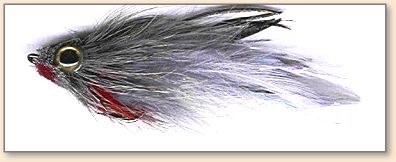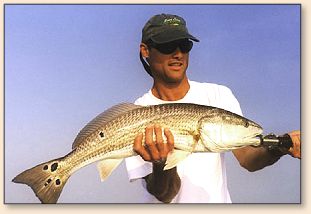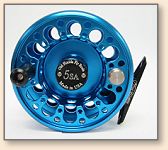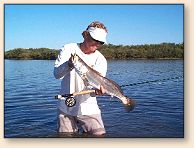Just rounding a bend from the remains of an old sugar
barge, we heard loud yelling.
"DUCK! DUCK!"
SPLASH, SPLASH!
"COME BACK! NOW!! COME BACK!"
Came the cry from across and down a bend in the creek.
We were somewhat alarmed by hearing what could be hunters
snuggled in a secluded blind. As we rounded the corner
we could see clearly what was happening.
A fisherman and his friend had taken their two labs out
fishing. It was a beautiful morning with a light mist
on the water. When they located their favorite fishing
spot, they spotted the ducks. The captain's friend yelled
out those words and the dogs immediately dove in the water
in chase after the ducks.
I remember Rob doing that in my father's boat. It took 5
towels to dry him off before I put him in my truck. Dogs
seem to have a keen eye and liking for ducks or any fowl,
and fish too. Rob and Lula were no different. After a
while Lula was left home because she would jump in the
water just to swim. Rob liked to scout on the bow,
vigilant of anything moving in the brush or along the
waters edge. At an early age we had to tie him in the
boat and after awhile he learned that he wasn't supposed
to jump out unless someone called "DUCK!" He was real
good at spotting redfish and was my First Mate on many
charters.
We were at the opening to Slann Creek where the old sugar
barge is still partially submerged. Rotten and decayed,
it is a legacy of an earlier period when colonists shipped
many staples including cane sugar and molasses up the Neuse
River and the port of New Bern (namesake to Bern, Switzerland).
John Wright Stanly was a leading ship owner, shipper, and
molasses distiller in New Bern. He had trade connections
with both Philadelphia and the West Indies. Active during
the American Revolution, Stanly provided much needed
supplies for the American forces and used his ships as
privateers against the British. Stanly lost 14 ships during
the Revolution. After the Revolution, Stanly continued to
serve as a prominent leader in New Bern. He was appointed
by President George Washington (Washington, NC is named
after President Washington and to this day is referred
to as "Little Washington") as the first judge of the
Maritime Court in North Carolina.
There was severe shoaling in those days and since. The
rivers and creeks that feed the Neuse brought a lot of
silt from the farms and clogged many areas. So a lot
of old barges ran aground and were never removed. Luckily
for us, the old sugar barge is a handy landmark to point
us to Spotted Sea Trout and Puppy Drum heaven.
We moved on in passed the boat with the guys yelling at
their dogs. You could see those dogs wagging their
tails in the water as they made their way back to the
skiff. The anglers weren't too happy but you couldn't
blame the dogs.
Back in the creek a small cut runs to the bank and a
deep, deep hole channels to the west. My, my, my,
this is a beautiful spot. This watershed is protected
on three sides by high pine trees. Talk about flat
water - the water is smooth as glass.
The fly rods were pulled out from under the gunnels.
Fred took the 8 weight HP, his favorite rod (actually
my rod). It has a Wulff Bermuda Triangle Taper
Tropical Line with a 16-pound Mirage knotless tapered
leader and a 20-pound bite tippet. Our flies were
simple. Three colors, exactly the same pattern of a
Ponce Mullet and a Gray Puppy Drum fly (below).

The Puppy Drum fly lays up partially submerged and has
a nice swimming action. It is most effective in early
morning or late afternoon. A slow strip action moves
the fly and the tail undulates in the water like a
wounded mullet. This is a very effective fly on stripers,
jacks, blues, trout and Reds (when tied in white or olive).
It was too early for sight fishing, so we looked for
pushes along the edges of the grass or along the myrtle
shrubs and cat-nine tails hugging the bank. You could
hear mullet piercing the surface. And, an explosion of
bait behind us.
"REDS!!" Charlie yelled. A big school was breaking up
bait on the surface moving towards us.
"Fish on" yelled Fred. We could see the pouncing of the
red over the fly as it was inhaled inside of his mouth.
It was an over-sized red. Typical for a red, he hunched
his shoulders and tore across the creek at warp speed,
then ran down the creek a ways, line was ripping off
the reel. Fred and Charlie yelling. . .
"FISH ON! WOW, WOW, WOW."
"LOOK AT HIM RUN."
"WOW".
In all the commotion, Charlie forgot to reel in and all
of a sudden line started running on his rod too. It was
a good thing I didn't have the drag tight or I would have
lost a $900 outfit.
"Charlie, grab that rod. You have a fish on!" I yelled.
He hadn't even noticed that the line was running out. He
was so mesmerized by Fred's hook up he didn't notice his line.
"IT'S A DOUBLE" he yelled, "IT'S A DOUBLE!"
"START REELING!" I yelled back.

It was a miracle we were able land both fish, take the photos
and release thm. Double hook ups are difficult to manage.
Easier in a creek than a big flat. And, they hadn't had
their fill, because I found the school again and we were
on fish for the next two hours.
 The Old Florida Reels were really humming. We were
using the 5SA Super Arbors with the big cork drags
that can stop a freight train and are smooth as silk.
The Old Florida Reels were really humming. We were
using the 5SA Super Arbors with the big cork drags
that can stop a freight train and are smooth as silk.
For another hour we pursued these reds and then they
disappeared. Further down the creek you could here
some more bait being chased.
"Captain, are those reds?"
"I don't know but I don't think so." I replied.
I was right. On the next bend and about a mile from
where we had jumped the reds, gator trout were rolling
on some menhaden. The creek was on fire with activity.
So we snuck up as closely as we could. I had Charlie do
the first cast because he was the longer caster. At this
point I handed Charlie the Old Florida 8wt rod with a 5
SA reel and Royal Wulff BT mono clear saltwater line.
I wanted the presentation to be very stealthy. That
rod was all set up with an SA Bonefish 16# tippet and
bead eye olive and white deceiver.
"Give that push a long lead and let the fly sink!" I said
to Charlie, "Make short quick strips".
No sooner than that fly hit the water did Charlie have a
fight on his hands. The trout pulled hard and the rod
tip bent, down. The spotted sea trout made a swift run
along the bull rushes and over near on old cypress stump.
I was worried that we would get hung up in the roots.
"Quick, Charlie, Turn him!!" I yelled.
Fred put side pressure on the rod and pulled hard to turn
the trout. We didn't need him running into the roots or
we would never get him out. The trout dove down and the
rod tip bent under pressure from this 7 pound trout. Fred
pulled harder and down. The pressure seemed to work as
the trout made a run at the boat.
Nice fish," Fred yelled.
"7 pounds on the Bogga grip," I said, "indeed this is a nice,
nice trout."

We had quite a good day of fishing. Time passed quickly
even after many hours of fishing. They almost forgot
about lunch, but remembered just as I was about to head
back to the Neuse and up the river to drop them off at
the Sheraton Grand's dock, a convenient pick up point
for anglers.
The old sugar barge just sat at its pins as we motored by.
The relic was still a beacon for finding a great fishing
spot and lots of fun for these fly anglers.
"Great day, Captain, we'll have to do this again."
Please don't teach your trash to swim. ~ Doug Sinclair
About Doug:
Capt. Doug Sinclair has relocated from New Smyrna Beach, Florida to
Grantsboro, NC. He specializes in fly-fishing and light tackle charters.
Doug charters the Coastal Carolina area of New Bern or Oriental.
Catch him on the web at
www.flyfishacademy.net or call him at (252) 745-3500.
Doug is also a Sponsor here on FAOL.
|




 The Old Florida Reels were really humming. We were
using the 5SA Super Arbors with the big cork drags
that can stop a freight train and are smooth as silk.
The Old Florida Reels were really humming. We were
using the 5SA Super Arbors with the big cork drags
that can stop a freight train and are smooth as silk.